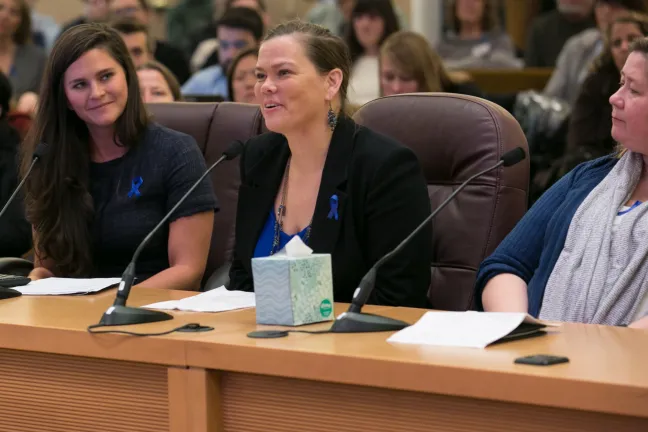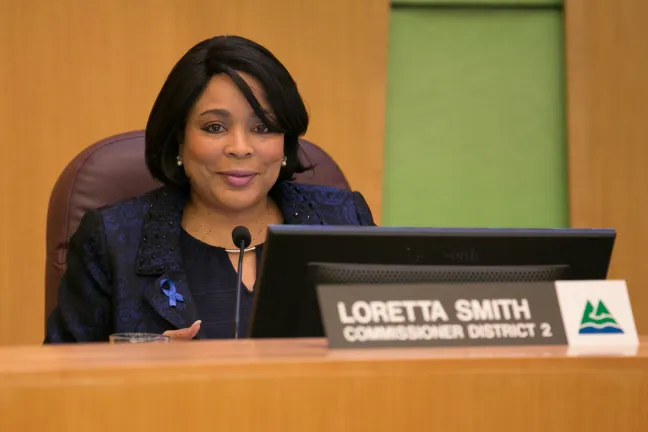Robin Miller was just 21 years old when the exploitation began.
“In 1993, I was trafficked from a club in Portland,” Miller told the Multnomah County Board of Commissioners. “I was trafficked up and down the West Coast and in six states.”
“It took me six years to finally get the courage to leave my trafficker in 1999,” Miller said. But healing from the abuse took more than a decade more, in part, because there was no coordinated system of care available to support survivors, she said.
“When I got out of the life, there were not services specific to my population… especially not a collaboration,” Miller said. “It took me about 13 years before I could allow them all to fall into place and walk into my healing.”
Miller addressed the Board of Commissioners on Thursday just before the body adopted a proclamation recognizing January as Human Trafficking Awareness Month in Multnomah County. The resolution calls on county residents to “actively work towards the elimination of human trafficking by supporting victims, holding perpetrators responsible, and promoting healthy, respectful relationships.” It is intended to raise awareness of human trafficking in Multnomah County and also to affirm the County’s commitment to ensuring that people in situations similar to Miller’s can find the support they need.
The resolution was submitted by Commissioners Jessica Vega Pederson and Loretta Smith.
“Human Trafficking is a huge issue within our county. It’s a huge issue across our nation as well,” said Vega Pederson, who serves as chair of the Multnomah County Commercial Sexual Exploitation of Children (CSEC) collaborative. “Too often, today, we are seeing people -- particularly those who are young, or low-income or from communities of color -- taken advantage of and abused for the profits of others.”
As of December 2017, there were more than 1,300 victims of commercial sexual exploitation in Multnomah County, including 327 minors. There were also 900 suspected traffickers.
By law, sex trafficking is the recruitment, harboring, transportation, provision, or obtaining of a person for the purpose of a commercial sex act induced by force, fraud, coercion or manipulation. For victims under age 18, there is no need to prove force, fraud, coercion or manipulation.
“The continued victimization of underaged members of our community must bring us to a place of outrage coupled with action,” Smith said. “We must be deliberate in dealing with those who feed on vulnerable youth and adults. We must use our laws and policing resources to bring those engaged as johns and as pimps into the criminal justice system and hold them accountable for the harm they bring to these victims and to our community.”
The 10-year-old CSEC collaborative is Multnomah County’s comprehensive community response to trafficking, which prioritizes restoration of the survivor above all else. The collaborative partners with law enforcement, investigation and prosecution to deter exploitation and promote accountability, said Natalie Weaver, the Sex Trafficking Collaboration Specialist at the Department of Community Justice. The collaborative uses prevention, public safety, health and human services programs to address human trafficking.
Last year, it provided more than 50 trainings to more than 1,500 service providers, private entities, businesses and community members, Weaver said.
Still, there have been setbacks in the work.
Late last year, for instance, Athena House, a residential recovery program for victims of sex trafficking, closed after Multnomah County ended its funding amid questions of mismanagement by the nonprofit operating the residence. The three teenagers living in the home at the time were housed elsewhere.
But the closure of the Athena House allowed the County to think about how it could redesign the system of care for victims of sex trafficking, said Rose Bak, co-director of the Youth and Family Services division of the Department of County Human Services.
Bak said the team researched promising practices around the country, interviewed a national expert on sex-trafficked youth, conducted site visits to observe other programs, conducted focus groups with current partners and people who might come in contact with trafficked youth, and spent an afternoon talking with sex-trafficked youth who had gone through the existing system about their experiences.
“And then we designed a new system that was based on what we heard,” Bak said.
The County plans to issue a request for proposals this week to procure an organization to provide services for children and young adults who are victims of sex-trafficking. The goal is to find a provider that will make sure the County provides reach more youth, particularly youth of color and those who identify as LGBTQ, with trauma-informed, culturally competent services.
“We’re deciding on a very careful evaluation of these services,” Bak said. “And we’ll be incorporating a much more comprehensive performance component and youth engagement component.”
Miller, who now advocates for and provides direct services to people ages 12 to 24 who are experiencing commercial sexual exploitation, said the County’s work is “on the right track.”
“I was at a trial (in Multnomah County) supporting a victim who was testifying against her trafficker,” said Miller, who also is part of the anti-trafficking task force in Clark County. “It was really powerful to see all of these agencies -- who I used to be so afraid of, who used to put me in jail -- working together to support this woman.”
“Portland is really on the map in doing great work,” Miller said. “I just can’t wait to see how much better it gets in the coming year and years to follow.”



